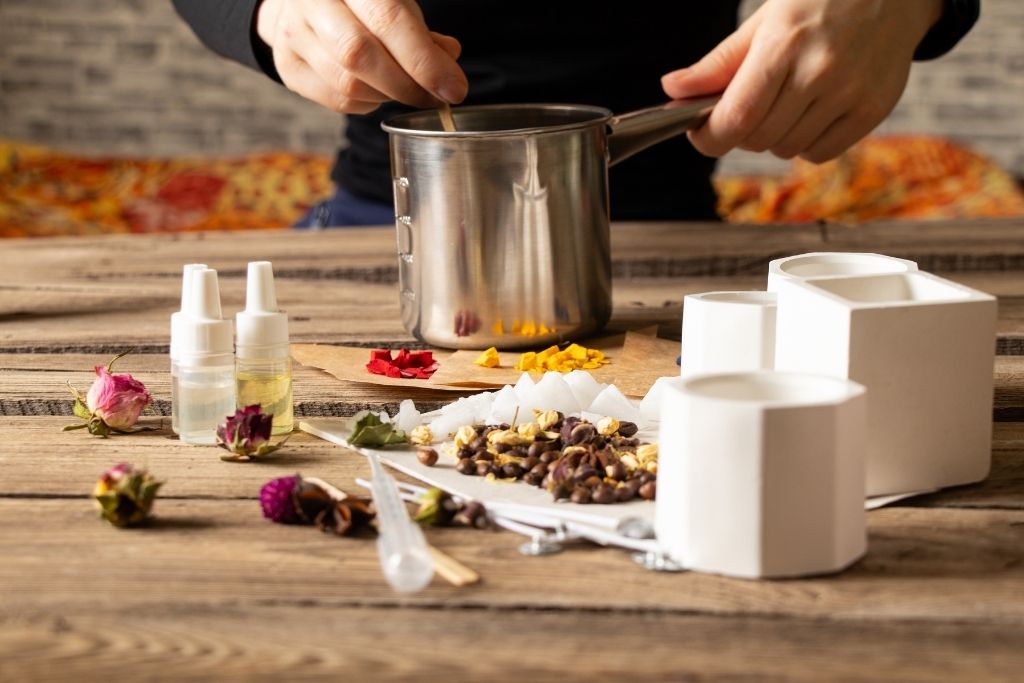Choosing the right fragrance oil can be the difference between a candle that just sits there and one that instantly sets a mood. The best fragrance oil matches the type of wax, complements the vibe you want, and actually throws scent both hot and cold. If you get how fragrance oils play with wax – and how scent can shift a whole atmosphere – you’re already ahead of the game.

There’s a mind-boggling variety of fragrance oils, each with quirks that affect how your candle turns out. Some are made for soy wax, some for paraffin, and others for coconut blends. Getting familiar with these differences means your candles won’t just smell good – they’ll burn clean and even, too.
Scent isn’t just a finishing touch. It shapes how a room feels. Lavender’s great if you want to chill out, but a sharp citrus or fruity scent wakes up a kitchen. With a little intention, fragrance oils aren’t just an ingredient – they’re the soul of your candle.
Understanding Candle Fragrance Oils
Fragrance oils are at the core of what your candle smells like, how it burns, and whether the scent lingers or just disappears. The makeup of the oil – natural, synthetic, or a mix – directly impacts quality and safety.
Defining Fragrance Oils and Their Components
Fragrance oils are basically liquid blends made for candles, mixing aromatic compounds with a carrier. Those compounds might be essential oils, lab-made aroma chemicals, or both. The carrier helps the fragrance oil blend into the wax and release scent when the candle’s lit.
A few things determine how well a fragrance oil works:
- Flash point: when the oil starts to vaporize.
- Scent throw: how strong it smells, cold and hot.
- Compatibility: how it plays with different waxes (soy, paraffin, coconut, etc).
Good fragrance oils are tested for stability and safety. They should burn clean and not give off nasty byproducts. Most reputable suppliers will hand over IFRA certificates so you know what’s safe before adding fragrance oils.
Natural vs. Synthetic Fragrance Oils: What You Need to Know
Natural fragrance oils are all about plant-derived stuff – essential oils, botanical extracts. If you’re into minimal processing, they’re appealing, but honestly, they don’t cover every scent and can fade fast under heat.
Synthetics are made in a lab. That opens up a much bigger scent library, plus you get stronger and more reliable results in candles. They can mimic nature or go off the beaten path.
Here’s a quick side-by-side:
| Type | Pros | Cons |
| Natural | Plant-based, minimal processing, eco-appeal | Limited scents, less stable, pricier |
| Synthetic | Huge variety, reliable, affordable | Chemically produced, not for everyone |
A lot of candle makers mix both to get the best of all worlds – authenticity, performance, and cost. That flexibility makes sense if you want your scented candles to check all the boxes.
Key Factors for Selecting Fragrance Oils for Your Candles
Identify Your Purpose and Desired Ambiance
Every candle’s got a job – maybe it’s for winding down, maybe it’s to wake you up, or maybe it’s just to cover up yesterday’s dinner. Lavender or chamomile is perfect when you want to relax; citrus or mint is better for a pick-me-up.
Think about the room, too. A tiny bedroom doesn’t need a scent bomb, but a big living room might.
Some quick pairings:
- Romantic: floral scents like rose, vanilla, sandalwood
- Relaxing: lavender, eucalyptus, chamomile
- Productivity: citrus, peppermint, rosemary
If you know what you want the candle to do, picking the right fragrance oil gets a whole lot easier.
Decode Scent Categories and Fragrance Notes
Fragrance oils slot into categories: floral, citrus, woody, gourmand, fresh – you get the idea. Knowing where a scent sits helps you avoid weird combos.
Every fragrance oil’s got notes: top, middle, and base. Top notes (lemon, bergamot) are the first thing you smell. Middle notes (jasmine, cinnamon) are the heart, and base notes (musk, vanilla) give the scent staying power.
A good candle usually layers these complex blends of scent profiles to create an inviting atmosphere. Like, citrus up top, floral in the middle, woody notes at the base – it’s more interesting that way.
Match Fragrance Oils to Your Candle Wax Type
Not all fragrance oils play nice with every wax type. Soy wax, for example, tends to mute scents, so you’ll want something with a strong throw. Paraffin wax is more forgiving and works with tons of fragrance oils.
Coconut wax throws scent well but can be a bit finicky – testing is a must. Beeswax has its own honey scent, so lighter fragrances like vanilla or almond usually work best.
It’s smart to check the manufacturer’s suggested fragrance load for your wax. Too much or too little oil can mess up the burn.
Prioritize Quality and Authenticity of Fragrance Oils
Quality matters. Cheap oils might smell strong in the bottle, but fade out fast when burned.
Go for oils that are phthalate-free, skin-safe, and actually specifically formulated for candles. Good suppliers will have safety data sheets and usage guidelines.
Store your oils right – dark glass bottles, cool, away from sunlight. It keeps them from breaking down.
Select Fragrances for Seasons and Special Occasions
People’s scent preferences change with the seasons. Spicy, warm scents like cinnamon or pine are winter classics, while florals and citrus feel right in spring and summer.
Special events are another chance to get creative. Vanilla and sugar-cookie sweet treats for holidays, or linen and ocean scents for weddings.
A cheat sheet:
- Winter: pine, cedarwood, cinnamon
- Spring: lilac, gardenia, fresh herbs
- Summer: citrus, coconut, tropical fruits, ocean breeze
- Autumn: pumpkin spice, apple, sandalwood
Best Practices for Using Fragrance Oils in Candle Making
Using fragrance oils right means your candles burn evenly, smell great, and don’t create excessive soot. Accurate measuring, smart blending techniques, and testing all matter.
Calculating Fragrance Load for Optimal Scent Throw
Fragrance load is just the percentage of oil to wax. Most people use 6% to 10%, but it depends on your wax and oil. Soy wax holds less, so you might need to bump it up.
To figure it out, multiply your wax weight by the percentage you want. Say you’ve got 500g of wax and want an 8% load – that’s 40g of oil. Always weigh, don’t eyeball it.
Too much oil can mess with burning or make the candle sweat. Always check the manufacturer’s limits and IFRA guidelines.
Techniques for Blending Fragrance Oils Like a Pro
Blending is often the most enjoyable part of working with fragrance. You do not need anything complicated to start with. A simple approach works well, such as using three parts of your main note, two parts of a supporting one, and one part of an accent. It keeps the mix balanced without becoming messy.
Certain pairings of different fragrance combinations tend to feel natural. Citrus often sits well with herbs, vanilla tends to shine with spice, and florals usually blend smoothly with woods. Begin with straightforward complementary scent mixes so you can really notice what is working and what is not.
It helps to keep a notebook to jot down detailed notes. Write down what you tried, what you liked, and what you would change. Once you are more confident, you can play around with layering oils at different strengths or even testing them in warm and cool conditions to see how the scent shift creates unique blends.
Why Testing Matters
Testing is essential when creating specific scents during the candle-making process. If you skip it, you will not know whether your candle gives off enough scent, burns evenly, or ends up tunnelling. Careful testing is what makes the difference between a nice idea and something truly enjoyable to use.
Make a small batch and check both cold throw and hot throw. Let candles cure for at least a week or two – it really does make a difference.
Take notes on burn time, scent strength, and anything weird that happens.
Troubleshooting Common Fragrance Oil Issues
Stuff goes wrong sometimes. Weak scent throw can mean you used too little oil, picked a poor-quality one, or your wax isn’t a good match. Try upping the load (within limits) or switching wax.
Sweating or oil seepage usually means too much oil or uneven cooling. Back off the percentage or control your cooling process.
Discoloration is common with oils that have vanilla. Stabilizers or different oils can help, and storing your oils properly keeps them fresher longer.
Frequently Asked Questions
What factors should be considered when selecting a fragrance oil for candle making?
Check if the oil blends well with your wax – soy, paraffin, coconut, whatever. Each handles and throws scent differently. Also, think about the room size; bigger spaces need stronger scents, while small rooms can get overwhelmed.
How can you tell if a fragrance oil is of high quality for candle production?
High-quality fragrance oils give you a reliable hot and cold throw. They shouldn’t reek of chemicals or vanish after curing. Suppliers who know their stuff provide testing notes and wax compatibility info.
What are some popular scent combinations for homemade candles?
People love mixing fresh and warm notes. Lavender with vanilla, citrus with rosemary, sandalwood with florals – these fragrance combinations just work. For holidays, cinnamon and apple or pine and eucalyptus are always hits.
Can essential oils be used in candles, and how do they compare to fragrance oils?
You can use essential oils, but they’re less stable and don’t throw scent as well in candles. Fragrance oils are built for performance. Sometimes, blending both gets you a natural vibe with better longevity.
How do you determine the correct amount of fragrance oil to use in a candle?
It depends on your wax and the supplier’s guidelines. Most folks use a fragrance oil calculator to get the right percentage (usually by wax weight). Too much oil can cause burning issues or sweating, so don’t wing it.
What are the safety considerations when working with fragrance oils in candle making?
It’s a good idea to wear gloves – fragrance oils can be surprisingly irritating if you get them on your skin. Honestly, you’ll want to work somewhere with decent ventilation too; those scents can get overwhelming fast. Pay attention to whatever max load the supplier suggests, or you might run into issues with how your candles burn. And don’t forget to label things properly and stash your oils away from heat or sunlight. It’s just common sense, but it really does help keep the oils fresh and avoid unnecessary risks.
